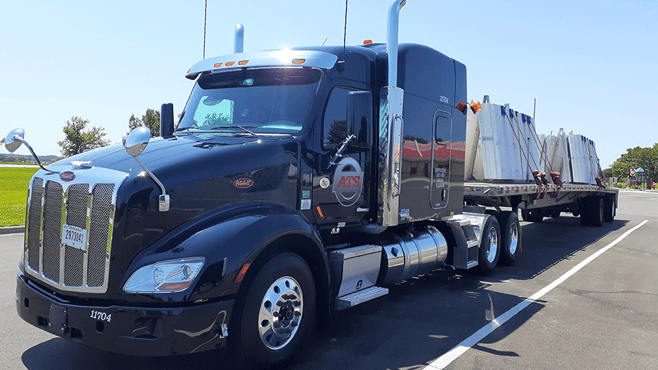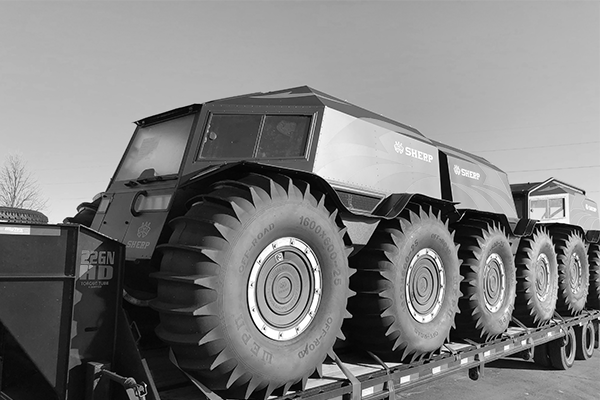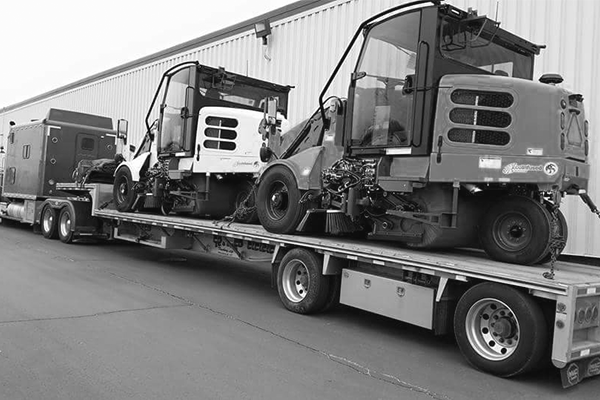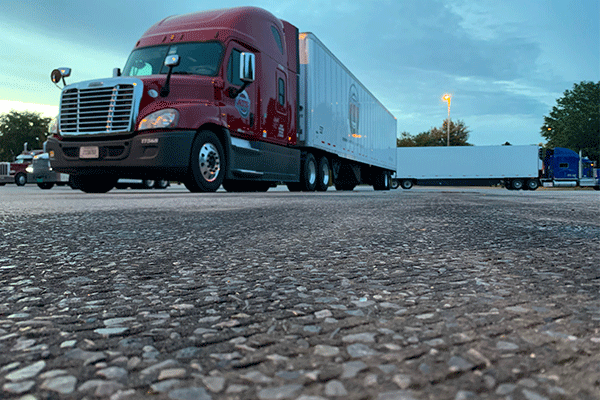
Getting freight to your consignee’s door quickly, when it counts, can make or break your timelines. Be it a single pallet of machine parts or a truckload of fabricated steel, delivering on your commitments is important to your relationships, your business and your bottom line.
That said, expeditiously moving freight — no matter how large or small — can be a challenge.
Sure, traditional less-than-truckload (LTL) and full-truckload (FTL) services provide a cost-effective option for meeting capacity demands but you’ve found they rarely do so in a timely manner.
No, you need a more reliable option to get your shipment to your customers and you need it quickly.
Enter; expedited shipping.
Here at ATS, we know that timing is everything in the transportation world — as we’ve been here for 65 years. That said, we also know how frustrating and disruptive failing to meet arrival deadlines can be.
In this blog, we’ll tell you everything you need to know about expedited shipping — the foremost solution shippers turn to when transit and delivery timing truly matters.
Stick around because, at its conclusion, this article will leave you with a better understanding of how expedited shipping is done, how it can make your life easier and when you should use it.
What is Expedited Shipping?
Expedited shipping is the process of moving freight in a time-sensitive manner. When utilizing expedited shipping services, shippers often prioritize on-time transportation service above and beyond their bottom line. And, since the transportation landscape is so fast-paced, moving freight quickly from A to B — when done correctly — can create tons of value.
Expedited shipping methods give shippers a way to cut down transit times and meet deadlines — adding additional value when they’re up against the clock.
How Does Expedited Shipping Work?
In its most basic form, expedited shipping is all about finding a timely transportation solution to meet your needs. When timelines are tight and your customer is waiting, a good partner will find an expedited solution catered to the characteristics of your freight.
The world we live in is incredibly fast-paced and things are only getting faster.
As such, a transportation company’s ability to find its customers a quick solution has never been more vital. To do this, the best transportation providers — such as freight brokers — lean on their expertise, network and creativity (believe it or not) to offer quick-fix solutions.
These solutions may come by leveraging their carrier network to find a driver close by. A driver who’s looking for a quick load to haul between longer commitments and your freight is the perfect fit to help him/her make the most of their time.
Or, your provider may be able to set you up with a hot shot trucker whose trailer space can become your dedicated solution from A to B.
Maybe a 53-foot dry van that wants to get to your endpoint? You may not even use its full capacity but if you’ll pay its driver to get he/she wants to go, you’ll likely get a relaxed rate without sharing trailer space.

Expedited shipping doesn’t necessarily get done by looking only at a single type of trailer or solution. . . because what if there aren’t any in your area?
No, the only thing that matters is that your freight gets to its destination and does so quickly. And, limiting your options may leave you hanging.
The greatest transportation partners understand this and consistently work to provide their service at the highest level by coming up with creative, out-of-the-box solutions. Solutions that change based on their customer’s needs.
For this reason, it’s difficult to pinpoint exactly how expedited transportation should be done. The rules, and options available, for hurdling the obstacles preventing freight from moving quickly change in each scenario. Every shipment is unique and faces its own set of challenges, expedited shipping is a testament to this fact.
That said, expedited shipping is most consistently done through one of four avenues.
The type of service you use depends on the quantity of freight in transit, the amount of transportation capacity available in your area and the expertise of your partner.
Let’s talk a little bit about each of these methods for expediting your shipment.
Related: Small Freight Shipment Service Guide [An Overview of Your Options]
What is a Team of Drivers?
In scenarios where an FTL shipment needs to be moved with urgency. Truck driver teams are the go-to solution for many providers. Using two truckers to haul a load saves shippers time — especially on longer hauls — that would otherwise be spent waiting for a trucker’s hours of service (HOS) clock to reset.
By employing multiple drivers, a load can avoid sitting in limbo for the 10 hours it takes for its driver to reset their on-duty clock.
This allows these driver teams to accomplish 1,000+ miles of driving within 24 hours. Since this is double the amount of miles a single driver would be able to put on, team drivers are highly effective in expediting shipments.
Note, the price paid by shippers in these scenarios can be steep as both drivers must be compensated for their work. As a result, expediting an FTL shipment can be costly if a team of drivers is needed to meet a tough deadline.
Related Content: Team Truck Drivers 101: What Using a Team Means for Your Freight
How are Sprinter Vans Used?
Sprinter vans are another way to haul smaller quantities of freight. These 19.5 to 24-foot vehicles can comfortably fit three standard-sized (40 inches by 48 inches) pallets and up to 3,000 pounds of total cargo.
While the cost of using a sprinter van to move your expedited freight may be a bit higher than using strictly LTL transportation services, it can be incredibly helpful for those whose supply chain it fits.
In particular, sprinter vans provide a timely solution for shippers looking to move LTL freight in two ways:
1. Sprinter Van Drivers Aren’t Regulated by the DOT

The Department of Transportation (DOT) outlines very specific guidelines for individuals operating motor vehicles with a gross vehicle weight (GVW) of greater than 10,000 pounds.
According to these regulations — which apply to traditional semi-truck drivers — any vehicle meeting this commercial motor vehicle criteria must follow hours of service (HOS) guidelines.
These guidelines dictate how long a truck driver can be actively on-duty within a 24 hour period of time (11 hours of “drive time”) and make it difficult for vehicles weighing more than 10,000 pounds to meet tight timeframes.
As a general rule, truckers with a registered DOT number — indicating the applicability of DOT rules and regulations — can drive 500 miles in a day if they’re lucky.
Sprinter vans don’t run into these same issues.
Since sprinter vans frequently fall under the 10,000 pound DOT threshold, the drivers of these vehicles aren’t subject to HOS regulations. In turn, this helps drivers drive a little faster and go a bit further than truckers pulling larger (48 to 53-foot) trailers.
2. Sprinter Vans Become Dedicated Trucking Solutions
When shipping LTL freight — freight that shares trailer space with many other loads — transit times can be unpredictable and freight handling can get out of hand.
You see, when shipping freight LTL, your goods aren’t given a dedicated solution for the duration of their journey. Instead, stop-offs are frequent and time sensitivity goes out the window.
Using sprinter vans to expedite the shipping process cuts down on these issues.
These vans become your freight’s dedicated start-to-finish shipping solution and, since you won’t need to share space or adjust to meet another party’s schedule, meeting tight deadlines becomes far easier.
How Are Straight Trucks Used?
Straight trucks are small semi-trucks where the tractor and trailer are all connected on the same frame. These vehicles typically measure 10 to 26 feet in length and offer yet another method for quickly moving less-than-truckload freight.
Generally, the straight trucks used for expedited A to B services can transport up to 12 pallets and 12,000 pounds of freight.
For shippers looking to move commodities with overall capacity requirements that fit within these confines, straight trucks cut down the transit times and handling (loading/unloading and shifting) issues of LTL shipping.

Note: Like sprinter vans, these trucks — depending on their GVW — may not be subject to DOT hours of service regulations. As such, straight trucks can be a quick solution for time-sensitive shipments.
Related: What Are Straight/Box Trucks and How Are They Used to Ship Freight?
What is Air Freight?
Shippers utilize air freight services to move goods from A to B using an air carrier. To do so, shippers — with assistance from their transportation provider — purchase the space within the belly of a cargo aircraft and send their freight toward its destination.
Although the price of these vacant cargo areas fluctuates from one provider to the next, the price of purchasing air freight is usually billed on a per-pound basis. As such, the more freight you need to move — taking up more space under that aircraft — the more you should expect to pay to secure that capacity.
What Are The Benefits of Expedited Shipping?

The benefits of expedited shipping mirror the main reasons shippers utilize it. The guaranteed delivery times make for easy supply chain planning and fast transit speeds make for smoother operations. Let’s talk a bit more about each of them.
Guaranteed Delivery Times
Expedited shipping makes it easy for shippers to know exactly when their freight will be arriving. Waiting around for a commodity to arrive on the back end can often be costly for business partnerships and timelines.
To combat this, expedited shipping provides a dedicated solution with predictable arrival times.
As such, shippers know exactly when their freight will deliver barring any unforeseen issues — an activity that’s made difficult by the speed and visibility issues of other options.
Related: Is Guaranteed On-Time Delivery Possible? [How You Can Help Make it Happen]
Heightened Transit Speeds
The businesses that utilize expedited shipping do so because speed in this fast-paced world is increasingly convenient. Expedited team drivers can sometimes cover upwards of 1,000 to 1200 miles a day, making these transportation services the quickest in the business.
In the transportation industry, transit speeds can sometimes be difficult to predict and hastening them isn’t always possible.
As such, using teams to increase the pace of traditional full-truckload shipments or sprinter vans and straight trucks for smaller loads, although priced higher, are tactics used by many shippers.
Couple in the fact that a flight from New York City to Arizona takes just over five hours to complete — as compared to 38 hours by truck — and using air freight solutions for smaller loads is also hard to pass up.
For the shippers who need freight moved quickly, expedited shipping makes a worthy companion no matter what form it takes.
What Are The Disadvantages of Expedited Shipping?

With the benefits of guaranteed delivery times and fast transit speeds, it’s hard to believe shippers would ever forgo expedited options, isn’t it? Don’t get too excited just yet though because expedited shipping, just like everything else, has a downside.
The main downside of expedited shipping is an objection that we probably hear the most often as transportation providers — “it costs too much.”
And this is certainly fair. Expedited shipping, although an excellent tool to be used in certain situations can certainly be more expensive than moving freight in other ways.
By securing a dedicated transportation solution for the sole purpose of moving your freight, you’ll need to compensate the driver for their time and any expenses incurred along the way.
As such, you should often expect to pay more than you would for other shipping services.
That said, by utilizing the right transportation provider — with a demonstrated history of moving expedited freight — securing capacity at a reasonable price-point is more than doable.
And in recent years — as truck capacity increases to tighten — the price of moving 8 pallets on a straight truck has been priced increasingly competitively with doing so LTL.
There is plenty of expedited capacity out there if you just know where to look. Make sure to ask your transportation provider whether expedited shipping will fit your budget and your needs.
Let’s Talk About More Transportation Services
Now that you have a better understanding of expedited shipping including how it’s done, what options are available to do so and what the benefits of expedited shipping are, you’re ready to dive a bit deeper into this industry’s many service offerings.
Although every shipper’s needs are unique, we guarantee there’s a service available to meet yours.
ATS takes pride in preparing shippers like you for success in the transportation world. To do this, we’ve compiled a ton of articles on the different services this industry has to offer. Check them out and ask your transportation provider whether they’ll fit your supply chain.
Many of these services have made a difference to our customers. Hopefully, they’ll help you too.
- The Advantages of Using Drop Trailer Service
- The Disadvantages of Using Drop Trailer Service
- What is Hot Shot Trucking
- What is White-Glove Delivery Service?
- What is Multi-Stop Truckload Shipping?
- How are “Milk-Runs” Used to Ship Freight?
- What is “Zone-Skipping” in Freight Shipping?
If you have any questions about how ATS can help you move your next shipment expeditiously, or whether any of the above services apply to your transportation needs, reach out! Helping shippers like you is what we’re truly passionate about.

